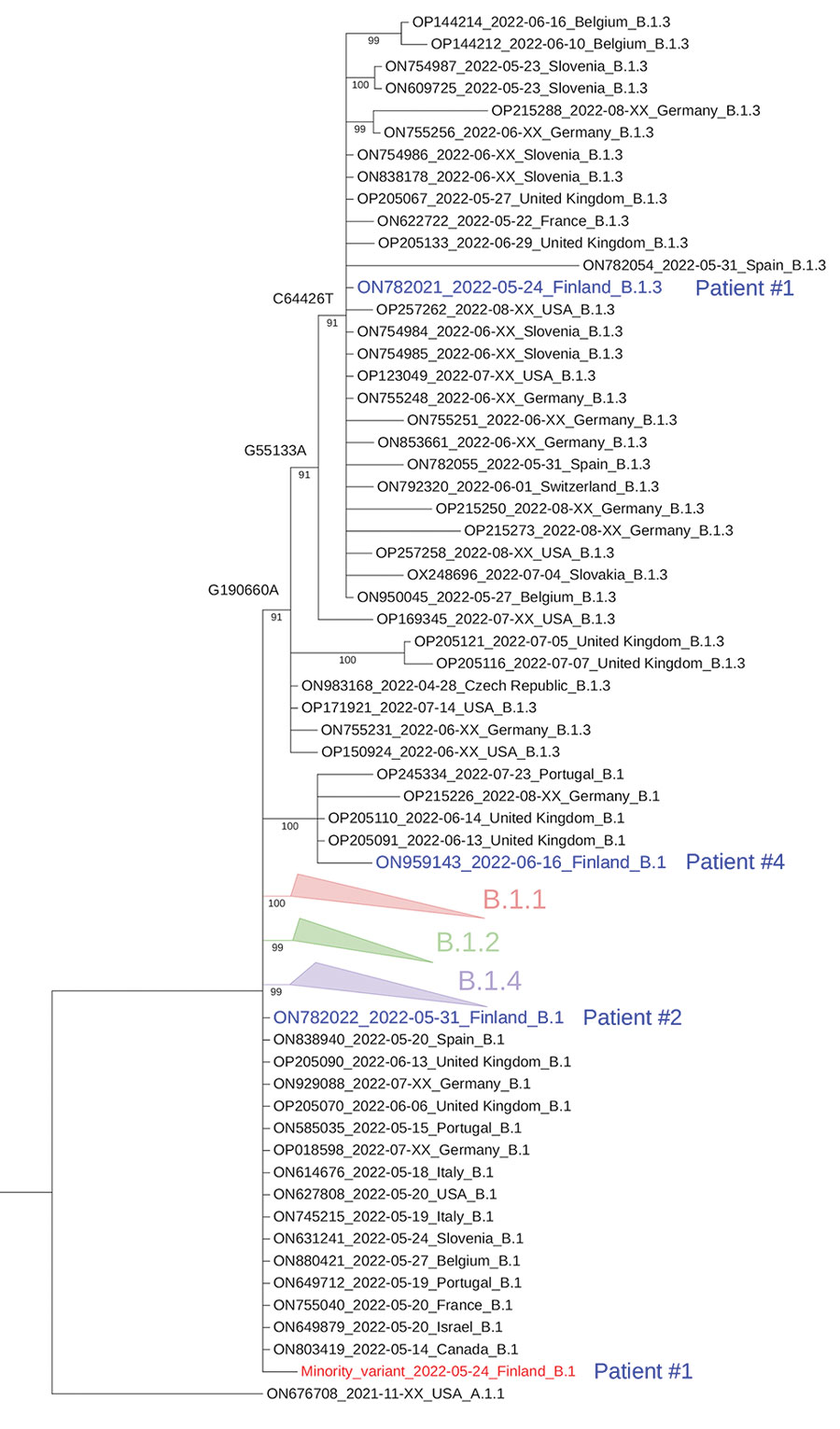Volume 29, Number 3—March 2023
Research Letter
Intrahost Monkeypox Virus Genome Variation in Patient with Early Infection, Finland, 2022
Figure

Figure. Phylogenetic tree of monkeypox virus (MPXV) sequences used in study of intrahost viral genome variation in patient with early monkeypox virus infection, Finland, 2022. The tree was inferred by the maximum-likelihood method implemented in IQtree2 software (www.iqtree.org), using 1,000 bootstrap replicates and the Hasegawa-Kishino-Yano plus empirical base frequencies plus invariate sites substitution model (Appendix). The curated dataset of MPXV reference genomes was downloaded from Nextstrain and aligned by using Nextalign (5). The reference dataset was downsampled to include only genomes with <5,000 ambiguous genome sites. For the sake of visualization, nodes with bootstrap values <70, as well as clusters with no lineage designation and no representatives from Finland, were deleted; only a subset of nearly identical genomes in the B.1 lineage is shown. Blue indicates the consensus sequences from the 4 patients from Finland; red indicates the hypothetical minority variant sequence (differing from the consensus sequence at sites G55133, C64426, and G190660) from patient 1. Lineage nomenclature (MPXV-1 clade 3, lineage B.1) is as suggested (C. Happi, unpub. data, https://virological.org/t/urgent-need-for-a-non-discriminatory-and-non-stigmatizing-nomenclature-for-monkeypox-virus/8537). The tapering bars indicate clusters of B.1.1 (pink), B.1.2 (green), and B.1.3 (blue), collapsed for clarity. Sequences are identified by GenBank accession number, date, and country of origin.
References
- Perez Duque M, Ribeiro S, Martins JV, Casaca P, Leite PP, Tavares M, et al. Ongoing monkeypox virus outbreak, Portugal, 29 April to 23 May 2022. Euro Surveill. 2022;27:
2200424 . DOIPubMedGoogle Scholar - Thornhill JP, Barkati S, Walmsley S, Rockstroh J, Antinori A, Harrison LB, et al.; SHARE-net Clinical Group. Monkeypox virus infection in humans across 16 countries—April–June 2022. N Engl J Med. 2022;387:679–91. DOIPubMedGoogle Scholar
- Iñigo Martínez J, Gil Montalbán E, Jiménez Bueno S, Martín Martínez F, Nieto Juliá A, Sánchez Díaz J, et al. Monkeypox outbreak predominantly affecting men who have sex with men, Madrid, Spain, 26 April to 16 June 2022. Euro Surveill. 2022;27:
2200471 . DOIPubMedGoogle Scholar - Karan A, Styczynski AR, Huang C, Sahoo MK, Srinivasan K, Pinsky BA, et al. Human monkeypox without viral prodrome or sexual exposure, California, USA, 2022. Emerg Infect Dis. 2022;28:2121–3. DOIPubMedGoogle Scholar
- Hadfield J, Megill C, Bell SM, Huddleston J, Potter B, Callender C, et al. Nextstrain: real-time tracking of pathogen evolution. Bioinformatics. 2018;34:4121–3. DOIPubMedGoogle Scholar
- Isidro J, Borges V, Pinto M, Sobral D, Santos JD, Nunes A, et al. Phylogenomic characterization and signs of microevolution in the 2022 multi-country outbreak of monkeypox virus. Nat Med. 2022;28:1569–72. DOIPubMedGoogle Scholar